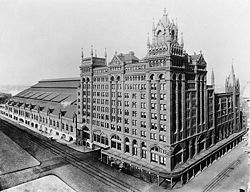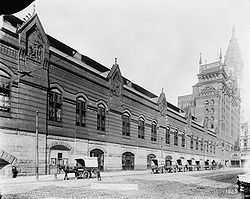
Broad Street Station (Philadelphia)
Encyclopedia

Pennsylvania Railroad
The Pennsylvania Railroad was an American Class I railroad, founded in 1846. Commonly referred to as the "Pennsy", the PRR was headquartered in Philadelphia, Pennsylvania....
(PRR) in Philadelphia, Pennsylvania
Philadelphia, Pennsylvania
Philadelphia is the largest city in the Commonwealth of Pennsylvania and the county seat of Philadelphia County, with which it is coterminous. The city is located in the Northeastern United States along the Delaware and Schuylkill rivers. It is the fifth-most-populous city in the United States,...
from 1881 to the 1950s. Directly west of City Hall
Philadelphia City Hall
Philadelphia City Hall is the house of government for the city of Philadelphia, Pennsylvania. At , including the statue, it is the world's second-tallest masonry building, only shorter than Mole Antonelliana in Turin...
, the office towers of Penn Center now occupy the site.
Originally designed by Wilson Brothers & Company
Wilson Brothers & Company
A prominent Victorian-era architecture and engineering firm established in Philadelphia, Pennsylvania, Wilson Brothers & Company was especially noted for its structural expertise. The brothers designed or contributed engineering work to hundreds of bridges, railroad stations and industrial...
in 1881, Broad Street Station was dramatically expanded by renowned Philadelphia architect Frank Furness
Frank Furness
Frank Heyling Furness was an acclaimed American architect of the Victorian era. He designed more than 600 buildings, most in the Philadelphia area, and is remembered for his eclectic, muscular, often idiosyncratically scaled buildings, and for his influence on the Chicago architect Louis Sullivan...
, 1892-93. In 1894, the PRR relocated its headquarters from Fourth Street to the office building above the station, where they remained until moving to the Suburban Station Building in the 1930s. It was finally demolished in 1953, a year after all train service to it had ceased.
Location and services

Schuylkill River
The Schuylkill River is a river in Pennsylvania. It is a designated Pennsylvania Scenic River.The river is about long. Its watershed of about lies entirely within the state of Pennsylvania. The source of its eastern branch is in the Appalachian Mountains at Tuscarora Springs, near Tamaqua in...
. The access tracks thus bisected the western half of Center City Philadelphia into north and south. Fifteenth Street ran beneath the station's lobby, and all the numbered streets up to 24th ran beneath the viaduct. John F. Kennedy Boulevard traces a similar path today.
The station was renowned for its architecture but cursed for inundating the heart of the city with the smoke and noise pollution of the day's steam-powered locomotives. The Chinese Wall also made Center City north of the station unfashionable, as the area was essentially cut off from the rest of downtown. Passengers arriving at Broad Street Station could make public transportation connections to the rest of the city via the numerous trolley lines that operated around it on Market Street and 15th Street, or via Philadelphia's east-west Market-Frankford Subway-Elevated Line
Market-Frankford Line
The Market–Frankford Line is a rapid transit line in Philadelphia, Pennsylvania, United States, operated by the Southeastern Pennsylvania Transportation Authority .-Route:The Market–Frankford Line begins at 69th Street Transportation Center, in Upper Darby...
(beginning in 1907) or the north-south Broad Street Subway starting in 1928. These latter two consisted of heavy rail lines that crossed under City Hall.
The Station provided service to virtually every destination served by the PRR. From Broad Street Station, passengers heading in any direction would first arrive at West Philadelphia Station at 32nd and Market Streets on the west side of the Schuylkill, which in 1933 was replaced by 30th Street Station
30th Street Station
30th Street Station is the main railroad station in Philadelphia, Pennsylvania, and one of the five stations in SEPTA's Center City fare zone. It is also a major stop on Amtrak's Northeast and Keystone Corridors...
. The lines then split off in three directions:
- Trains heading west towards Harrisburg would then take the PRR's line to 40th Street Station, 52nd Street Station, and Overbrook Station. Trains heading northwest along the Schuylkill would split off from this line after 52nd Street towards the stations at Wynnefield Avenue and CynwydCynwydCynwyd is a small village and community in the Edeirnion area of Denbighshire in Wales, located about south west of the town of Corwen. It had a population of 528 in 2001, and is home to a large factory, run by Ifor Williams Trailers....
. - Trains heading north towards New York City or east across the Delaware River to New Jersey would take the New York Division lines through North Philadelphia, North Penn Junction, and Frankford Junction Stations, before splitting off in their respective directions.
- Trains heading south would take the Baltimore & Washington RR Central Division line through Angora station.
Today all of these railroad lines, except for the one between 30th Street and Broad Street stations, remain intact as part of SEPTA or NJ Transit rail services.
Architecture


Gothic architecture
Gothic architecture is a style of architecture that flourished during the high and late medieval period. It evolved from Romanesque architecture and was succeeded by Renaissance architecture....
spires and arched windows, with considerable modification from their medieval sources. His work expanded on a similar structure originally constructed by the Wilson Brothers & Company
Wilson Brothers & Company
A prominent Victorian-era architecture and engineering firm established in Philadelphia, Pennsylvania, Wilson Brothers & Company was especially noted for its structural expertise. The brothers designed or contributed engineering work to hundreds of bridges, railroad stations and industrial...
a mere decade before. Furness's windows were often rounded and did not use pointed chancels.
The lower levels of the structure were heavy and rusticated, recalling the work of H. H. Richardson from the previous decade, while the spandrels of the upper stories emphasized the building's verticality. The frame for the stone structure was largely made of iron and steel, and on the interior the structural techniques were often displayed by balustrades and columns that in places revealed the rivets that held them together. The formal style of the building was altogether not unlike that of Furness's building for the Pennsylvania Academy of the Fine Arts
Pennsylvania Academy of the Fine Arts
The Pennsylvania Academy of the Fine Arts is a museum and art school in Philadelphia, Pennsylvania. It was founded in 1805 and is the oldest art museum and school in the United States. The academy's museum is internationally known for its collections of 19th and 20th century American paintings,...
, which he completed in 1876, or his University of Pennsylvania Library
Fisher Fine Arts Library
The Anne & Jerome Fisher Fine Arts Library, also known as the Furness Library, is located on the campus of the University of Pennsylvania, on the east side of College Green...
, designed in 1888.
As the station expanded after 1881, additional train sheds were added to cover additional tracks, twelve in all by 1891. They were eventually replaced by a single shed, which, upon its completion in 1892, had the largest single span of any station roof in the world (91 m), and ultimately covered 16 tracks.
PRR later hired Furness, Evans & Company to design the Arcade Building, an office building of the same red brick, stone and terra cotta as the station, that connected to it through a pedestrian bridge over Market Street. This relieved much of the pedestrian traffic at street level, and the City permitted the Arcade Building to be built over the 15th Street sidewalk.
Even in its early years, there were flaws in the operation of Broad Street Station. The station could not accommodate passenger trains passing through the city without time-consuming back-up moves. The other major problem was that it took a number of engine moves to turn around commuter trains, which had become the station's main business because of its proximity to the downtown area.
The first problem would remain unsolved despite a proposal for a tunnel in North Philadelphia that was to run to the Broad Street Station area and then emerge above ground to meet the lines coming out of the station. The other problem began to be alleivated with electrification of the rail lines, starting with the Paoli service to the railroad's "Main Line", starting on September 12, 1915. In 1918, service to Chestnut Hill (today's Chestnut Hill West) was opened, and the two busiest commuter services were dealt with.
In 1928, two more services, West Chester/Media, and Chester/Wilmington, would go under wire, and in 1930, Norristown and Trenton would be electrified, that latter being the first segment of electrification of today's Northeast Corridor, which was completed to Penn Station, New York, in 1933.
The train shed was destroyed by a fire on 11 June 1923. The fire began about 1:00 a.m. and burned for two days. Amazingly, work on clearing the debris began even while the fire was still smoldering. The steel skeleton that remained was fully removed; thereafter, the train platforms operated while covered by small, "umbrella" shelters. These replacements were destroyed by another fire that began at 9:38 a.m. on 12 September 1943 and were replaced by a similar structure that remained for the last ten years of the station's existence.
Demise
In the 1920s and '30s, the Pennsylvania Railroad constructed two new stations: 30th Street Station30th Street Station
30th Street Station is the main railroad station in Philadelphia, Pennsylvania, and one of the five stations in SEPTA's Center City fare zone. It is also a major stop on Amtrak's Northeast and Keystone Corridors...
, which is now the main intercity hub for Philadelphia rail travel, and Suburban Station, an underground stub line that went from 30th Street Station to a tunnel that ended just northwest of City Hall, directly north of Broad Street Station. (This line was later extended east as part of the Center City Commuter Connection
Center City Commuter Connection
The Center City Commuter Connection, commonly referred to as "the commuter tunnel", is a passenger railroad tunnel in Center City, Philadelphia, Pennsylvania, United States, built to connect the stub ends of the two separate regional commuter rail systems, originally operated by two rival railroad...
tunnel in the SEPTA era.) 30th Street Station was a through railway station that did not require intercity trains to turn around to exit the station (but a loop track was proposed just south of the station to allow the through east-west trains to come close to the center of the business district), while Suburban Station took over the commuter rail traffic. As a result, Broad Street Station's importance diminished dramatically. It ultimately suffered a fate similar to many of Furness's institutional buildings, as it was closed in 1952 and razed in 1953. The land once occupied by Broad Street Station and its access tracks is now the home to the commercial heart of the city, also known as Penn Center, including buildings such as the 54-story Mellon Bank Center
Mellon Bank Center
BNY Mellon Center is a 54-story skyscraper located in Philadelphia, Pennsylvania. The height to its structural top is 792 ft . Construction was completed in 1990...
. Today, all that remains of the building is a historic marker on 15th Street commemorating the site.
A bas-relief
Relief
Relief is a sculptural technique. The term relief is from the Latin verb levo, to raise. To create a sculpture in relief is thus to give the impression that the sculpted material has been raised above the background plane...
mural by Karl Bitter
Karl Bitter
Karl Theodore Francis Bitter was an Austrian-born United States sculptor best known for his architectural sculpture, memorials and residential work.- Life and career :...
, The Spirit of Transportation, located in the northwest corner of the main waiting area at 30th Street Station, was originally located in Broad Street Station.

